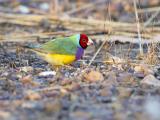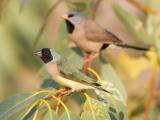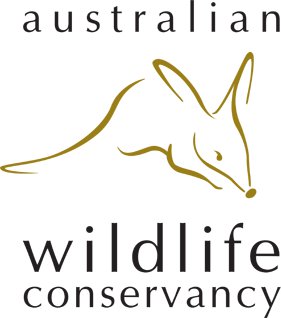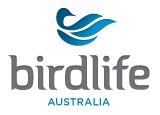Wildlife Profile - Gouldian Finch Erythrura gouldiae
| Order: | Passeriformes | Family: | Estrildidae |
| Genus: | Erythrura | Species: | gouldiae |
Distribution
Gouldian Finch range across northern Australia, much reduced from earlier times due to trapping and habitat degradation.
Ecology

Diet
Grass seeds, almost exclusively soughum (spear grass).
Life cycle
The only Australian grass finch to nest almost exclusively in tree hollows, favouring hollows in the Northern Salmon Gum Eucalyptus tintinnans. Breeding recorded in all months except October. Generally breeding between February and August.
Habitat
Open to very open grassy eucalypt woodlands. They show a strong preference for the presence of spear grass. Will always be reasonably close to water.
During the dry season we have regular sightings of Gouldian Finches in the Mary River district and also south of Pine Creek. These areas are part of the itinerary on Woodlands and Wetlands Tour, Kakadu Nature's Way, Kakadu Naturalists' Tour and Best of Top End Birding tour.
Gouldian Finch Census
Every September for several years a team from Canberra have come up to Wyndham, Western Australia, to gather data for a scientific survey that is aimed at providing answers to the many questions relating to the Gouldians survival and breeding in the wild. I was privileged to join the team, along with 26 other keen volunteers from around the Australia and even overseas, and three scientists, in September 2013. This was the last count of this nature as future monitoring efforts are refined, building on the knowledge aquired so far and utelizing new technologies.
Findings
Gouldian Finch numbers in the survey area (Wyndham, WA) are stable. The ratio of juveniles to adults has improved from 16-1 to 6-1. It has long been noted that there are good sightings of juvenile Gouldians and often few adults among them, so where do the adults end up? The answer could be that they may only be surviving for a single season. Several factors are putting pressure on Gouldian survival. Clearly they are good breeders, both in captivity and in the wild. But they are very choosy when it comes to selecting a suitable nest site. They will only breed in tree hollows that are of the right species, size and location. These birds are also very choosy when it comes to the grass seed that they eat. Fire regimes favouring pastoralists priorities degrades and destroys both food sources and nest sites for the 'Goldilocks' Gouldians.
The good news is that Gouldians readily use nest boxes that have been provided in suitable habitats by volunteers. These nest boxes are made from trees that have been felled by fire or cleared for agriculture. It can take one hundred years for such a tree, usually Northern Salmon Gum, to grow naturally to the ideal stage for Gouldians to nest in. Volunteers, cut the logs, clean them and position them. The provision of these nest boxes equates to stronger breeding success and probably less stress to adults through the breeding season. In fact, each nest box provided is likely to result in at least one successful brood per year. You can sponsor a nest here and have a part in this good news story!
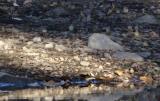
How many Gouldian Finches can you see in this photo? Look closely, then see the answer below.
Here are some links to help you find out more about Gouldian Finches Save the Gouldian Fund The Nest Box Project Scientific Papers by Dr Sarah Pryke
Please click here for an ABC Catalyst short video and article on Gouldian Finch sexual selection
Sources – HANZAB, Dr Sarah Pryke, my personal observations; Photos © Mike Jarvis
There are forty-four, four red-headed males, four black headed males, six black headed females and thirty juveniles
